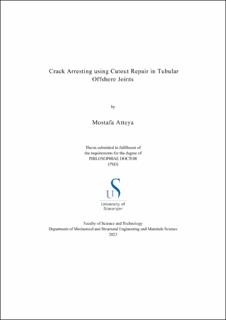| dc.contributor.advisor | Mikkelsen, Ove | |
| dc.contributor.advisor | Ersdal, Gerhard | |
| dc.contributor.advisor | Siriwardane, Sudath C. | |
| dc.contributor.author | Attaya, Mostafa | |
| dc.date.accessioned | 2023-11-07T07:59:06Z | |
| dc.date.available | 2023-11-07T07:59:06Z | |
| dc.date.issued | 2023 | |
| dc.identifier.citation | Crack Arresting using Cutout Repair in Tubular Offshore Joints by Mostafa Attaya, Stavanger : University of Stavanger, 2023 (PhD thesis UiS, no. 723) | en_US |
| dc.identifier.isbn | 978-82-8439-191-5 | |
| dc.identifier.issn | 1890-1387 | |
| dc.identifier.uri | https://hdl.handle.net/11250/3100925 | |
| dc.description | PhD thesis in Offshore technology | en_US |
| dc.description.abstract | Finding efficient repair methods for cracked tubular joints in offshore structures is important, both as a permanent or temporary repair solution. The exploration of such methods and techniques includes the use of hole drilling, possibly supplemented by techniques such as cold expansion, weld toe grinding and grooving. However, there is at present a lack of comprehensive understanding on the fatigue performance of tubular joints repaired by hole drilling and, even more so, on the use of crack deflecting holes. To address this knowledge gap, this research has experimentally investigated the fatigue performance of tubular joints repaired by crack deflecting holes. These experiments have been supported by detailed numerical analyses of the stress fields and the stress concentration factors around intact, cracked and repaired joints.
The study has revealed an unexpected location for fatigue crack initiation and further propagation after the hole drilling repair. This new fatigue crack initiation occurs at the weld toe behind the drilled hole, in contrast to the assumption in earlier work of crack initiation from the drilled hole. In addition, the work has observed a reverse coalescence of this new crack with the original crack. Such behaviour was observed both for crack-deflecting and crack-tip holes. This new insight also provides a reasonable explanation to the findings in earlier work on hole drilling as a repair method for tubular joints.
Furthermore, the experimental work indicate that crack-deflecting holes may be used to delay crack propagation in tubular joints, particularly for incipient through-thickness cracks. For fatigue in the high-cycle domain, this delay can be enhanced by weld-toe grinding in the area where the new crack is expected to initiate. The work also indicates that crack deflecting holes are more effective than crack-tip holes for tubular joints. In addition, the research has shown that cold expansion and grooving have limitations in tubular joints and may induce unfavourable stresses that could lead to premature crack initiation. These findings have been supported by finite element analysis that provides an explanation to the observed behaviour. The findings from this study provide valuable insights that can inform future repair designs for tubular joints in offshore structures. | en_US |
| dc.language.iso | eng | en_US |
| dc.publisher | University of Stavanger, Norway | en_US |
| dc.relation.ispartofseries | PhD thesis UiS; | |
| dc.relation.ispartofseries | ;723 | |
| dc.rights | Copyright the author | |
| dc.rights | Navngivelse 4.0 Internasjonal | * |
| dc.rights.uri | http://creativecommons.org/licenses/by/4.0/deed.no | * |
| dc.subject | offshore teknologi | en_US |
| dc.title | Crack Arresting using Cutout Repair in Tubular Offshore Joints | en_US |
| dc.type | Doctoral thesis | en_US |
| dc.rights.holder | ©2023 Mostafa Atteya | en_US |
| dc.subject.nsi | VDP::Teknologi: 500::Marin teknologi: 580::Offshoreteknologi: 581 | en_US |

